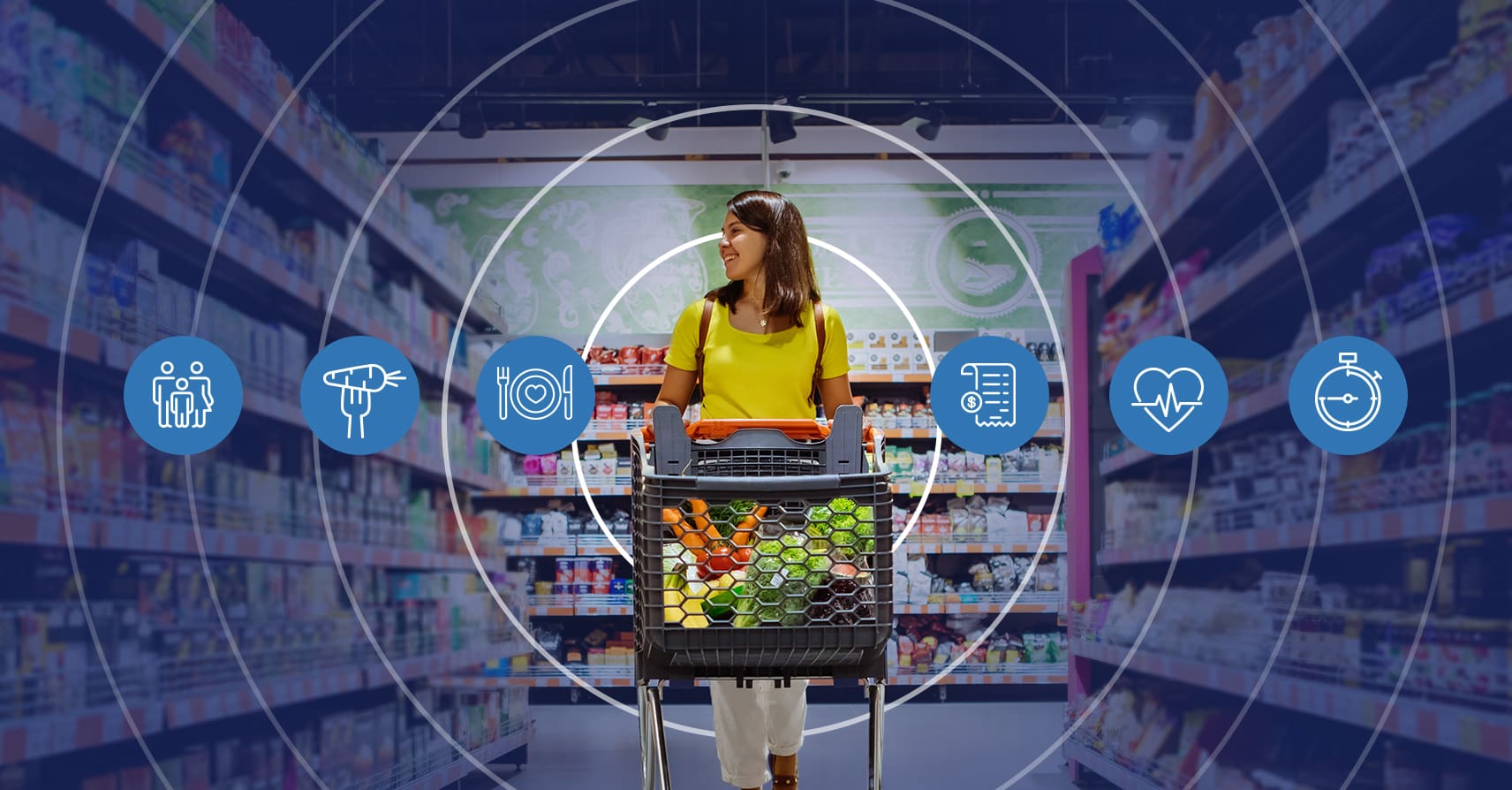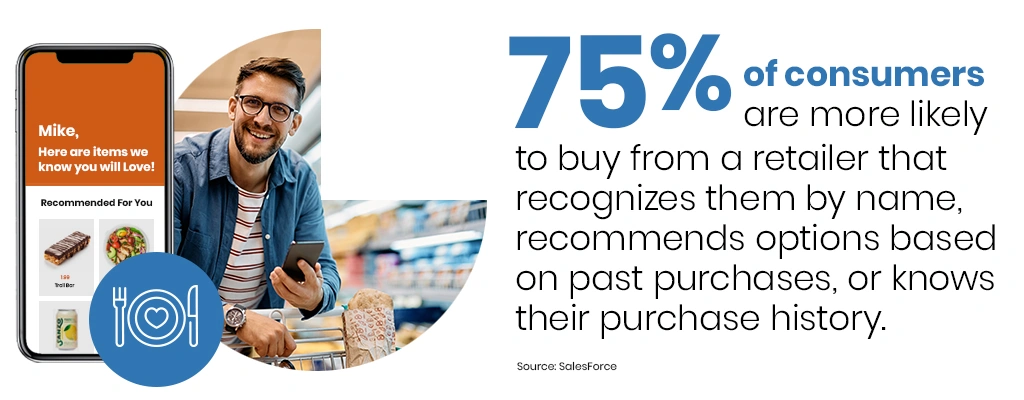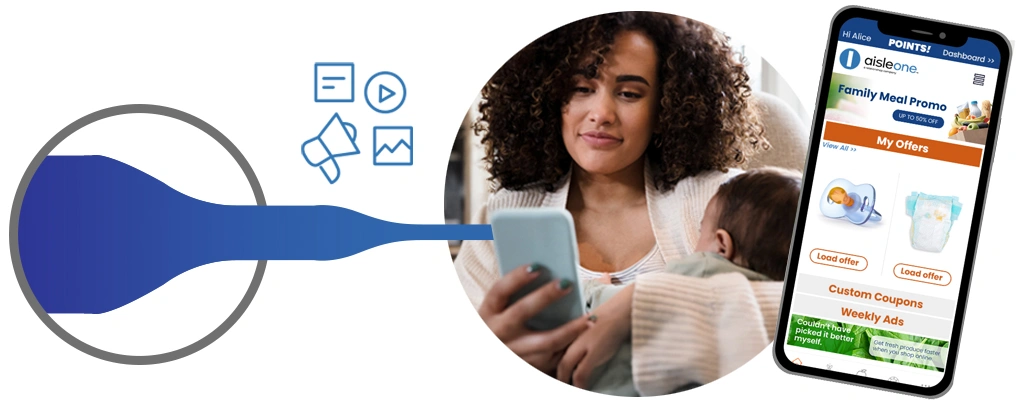
What’s the Result of Increased Personalization in Retail? Industry Transformation
This article was originally titled ‘eCommerce Personalization Explored in Grocery Retail – Trends and Pitfalls‘ published on February 16, 2019. It was revised on July 23, 2024.
There’s a reason why personalization in retail has long been a topic of interest for grocers.
Few areas of retail rely on providing a positive customer experience as much as the grocery industry. If customer loyalty — and, as a result, customer lifetime value — can be increased by providing personalized experiences, it’s only natural that grocers would be drawn to a personalization strategy.

Until only recently, however, there have been several challenges to implementing personalization at scale.
These roadblocks have included the requirement of complex coding, the need to hire additional staff for development work, and unifying customer data and purchase history without completely overhauling retail operations. And even if these traditional challenges were to be overcome, the level of personalized communication to come out of these personalization efforts wasn’t nearly as engaging as it is now.
Because of the progress of machine learning and artificial intelligence, combined with other technological innovations that have allowed grocers to better retain control of their customer experience, a new level of personalization in retail is now possible.
This modern contextualized customer engagement opens the door for regional grocers and independents to implement the types of personalization strategies that allow them to win back their market share from larger retailers — and potentially transform the entire grocery industry in the process.
The Modern Consumer Demands Value and Convenience
While many grocers obsess over per-product pricing as a means of competing with larger retailers, the most effective strategies for maintaining and winning back market share have been connected to answering modern consumer demands for value, yes, but also convenience.
Due to inflation and general economic uncertainty, the modern consumer insists on getting value from their shopping experience. We see this on a monthly basis in the sales data and cross-shopping figures coming out of the Mercatus/Brick Meets Click Grocery Shopping Survey.
But it’s not all about lower product prices. The modern consumer has also grown accustomed to the convenience that eGrocery services provide. We know this to be true because of the market stabilization that has occurred since the initial rise of online grocery shopping during the pandemic, as recently outlined in the 2024 Brick Meets Click U.S. eGrocery 5-Year Sales Forecast.
How Personalization Meets Modern Consumer Drivers
Regional grocers and independents are never going to be able to provide the consistently lower per product prices that Mass Merchants can. However, they are able to provide targeted savings — discounts, coupons, and rewards for specific products that the customer regularly purchases — through personalization.

When coupled with the convenience of personalized product recommendations — all based on past purchase history and timed to individual purchase cycles — grocers can use personalization technology to provide the type of customer experience that modern consumers demand.
What modern personalization in retail provides is essentially an update on the classic circular. But instead of generic offers to the same market segment, personalization offers a highly targeted approach to meeting individual customer preferences that goes far beyond a mere region-based customer segment. In this light, it’s easy to see how century-old traditions like print home flyers are quickly becoming antiquated.
The painfully negotiated, expensively built, and distributed, one-size-fits-all print flyer delivered on a fixed weekly schedule is no longer going to cut it alongside modern personalization in retail. All of that expense and effort to deliver a non-personalized “guide” to what’s on sale in the store can be smartly offset with the right technology.
The Importance of Leveraging Customer Data
To reach individual customers with highly targeted offers, grocers first have to know which offers will resonate. That’s why the deep level of one-to-one personalization we’re describing above depends on unifying and utilizing customer data.
Grocery executives know that inside their point-of-sale and loyalty program lies reams and reams of customer data. Grocers have at their disposal millions of rows of transaction logs, product descriptions and ingredients, pricing and promotions data, and often loyalty data. What individual customers previously purchased is all there, too, ready to be enlisted in personalized product offers tailored to each shopper.
The right technology can be used to unify all of this data, and shape it to form the basis of the grocer’s personalized communication with the customer. When you use purchase history to remind shoppers what they like to buy through targeted sales and promotions, you bring the discovery process to them, timed to their purchase cycles, while appealing to their financial needs. You’re providing both the value and convenience that drives customer behavior.
Contextualized shopper engagement allows grocers to further enhance the personalized shopping experience by saying, “You typically buy this product every 14 days. Do you need it now (two weeks after the last time you purchased it)? If so, enjoy this discount.”
Because the latest in personalization technology provides grocers with the ability to leverage their existing customer data in this way, determining preferences is no longer about customers filling out online forms. Research departments used to conduct shopping basket analyses. Now, grocers can ensure secure and scalable access to their customer insights while bringing together disparate data sources to create a single view of their customer base.
With a holistic view of their customers provided by automated tracking of individual digital, transactional, and promotional activity data, grocers can further segment customers, analyze their behaviors, and activate on those insights with the types of targeted content, offers and promotions described above via multiple communication channels: web/app content blocks, email, push notifications, SMS/text, and social media channels.
Modern Retail Personalization Efforts Enhances Customer Loyalty
We began this article by suggesting that personalized customer experience is more important in the grocery industry than it is for many others in the retail industry. A focus on customer engagement is necessary because grocers need to sell everything in their store, and shopper baskets are anything but simple when predicting who will buy what products.
Filling a shopper’s basket involves multi-facet fulfillment, from consumables to durables. It involves multiple persons, including the household shopper, their family, and potential guests. Finally, a grocer must appeal to all these elements across multi-occasions, from weekly shops to seasonal ones and the occasional special events.
And now, grocers have to contend with the increasing market share being taken by large retailers that are able to use economies of scale to offer lower pricing than regional grocers and independents. But as we also noted earlier when discussing modern consumer drivers, it’s not all about lower prices.
The eGrocery Performance Benchmarking report, from Brick Meets Click and Mercatus, identifies two main factors, beyond price points, that are driving customers away from grocers and toward larger retailers:
- Technology and Retail Personalization Gap: Many grocery stores have failed to implement advanced technologies and provide personalized shopping experiences. As a result, customers are migrating to competitors that offer more tailored services.
- Inadequate Shopper Engagement and Loyalty Programs: Retailers who lack effective engagement strategies and robust loyalty programs are at a disadvantage. They are losing customers to competitors who provide more valuable and personalized shopping experiences.
The goal of any grocery store loyalty program is to encourage large, consolidated orders on repeat. However, the report suggests that traditional loyalty programs — characterized by modest discounts and generic messaging — are insufficient for today’s consumers. Modern shoppers expect more than static rewards programs; they seek personalized experiences, data-driven engagement that provides value and convenience. They want retail personalization.
To remain competitive, grocers must develop a comprehensive customer engagement strategy that includes a personalized loyalty program. This approach not only leverages data — as outlined in the section above — to offer customized experiences and rewards that resonate with individual customers, but also contributes to greater loyalty and long-term engagement by constantly collecting new data as part of the loyalty program.
This is why personalization strategies are so vital to grocers, and why the implementation of these strategies have the potential to transform the industry. It’s the key to winning back market share from bigger retailers.
The Challenges of Personalization in Retail
Now that the technology exists to provide personalized experiences for customers at scale, without the considerable effort it required in the past, grocers are in a better position to compete. However, there are still challenges and pitfalls to avoid.
With Great Data Comes Great Responsibility
Grocers need to ensure that they always follow local laws and stay compliant with their data collection practices. Often, that means obtaining customer consent when collecting personal information and disclosing how the data will be used.
New regulations on data privacy are always being introduced, meaning that grocers should pay heed to these changing laws. These rules often require anyone collecting data to tell customers up front about the intended purpose of collecting their information.
Beyond legal responsibilities, securing customer data is of the utmost importance. The entire point of personalization in retail is to provide a better customer experience. Having personal data stolen or leaked is the exact opposite of this.
That’s why any personalization technology integrated by a grocer must include a modern authentication security model and modelling training completed on an isolated database network.
It’s Not What You Ask, It’s How You Ask
When seeking permission from customers to use their data and information, grocers need to walk a fine line. No grocer wants their brand associated with invasive practices. Instead, the focus should be on transparency and customer control.
In the past, Mercatus has conducted research into customer data preferences. One survey, involving over 50,000 American grocery shoppers, reveals key insights into this issue.
We asked: “With online grocery ordering, there is the opportunity to have your experience personalized with product recommendations based on the information you have shared about yourself with a grocery brand. Which of the following would you be willing to share with your grocer in order to create a more personalized shopping experience, including online and in-store promotions tailored to you?”
The results were remarkably consistent. Customers appreciate personalized recommendations, but are cautious about how their data is used. The key takeaway is that explicit consent for each category of information is crucial. While broad consents (signing up for a loyalty card) are legally sufficient, customers often prefer — and appreciate — a more nuanced approach.
Control Customer Experience and Gain Customer Data
If you want to be exceptional at providing personalized shopping experiences to your customers, it’s vital that you retain control over their data. Specifically, that means not relying on third-party convenience at the cost of first-party engagement.
Many retailers initially turned to third parties like Instacart as a means of dealing with the pandemic-related shift to online grocery delivery because these platforms offered a rapid response to the sudden surge in demand. This enabled grocers to quickly cater to their customers’ immediate needs without the time and investment required to develop their own digital infrastructure.
Now that the eGrocery market has stabilized, however, a new challenge has emerged that requires grocers to take greater control of their customer journey and all the data associated with it.
Instead of enhancing customer experience, reliance on a third party for digital engagement, order fulfillment, and in-store convenience results in:
- Lack of Personal Touch: The unique brand identity and personal touch that grocers can offer isn’t felt by customers.
- Data Disconnection: Grocers miss out on crucial insights into shopping habits and preferences, limiting their ability to personalize and improve the shopping experience.
- Communication Barriers: Third-party platforms impede direct feedback and the ability to address concerns promptly.
- Loyalty to Platform: The convenience of a third-party platform encourages loyalty to the third party rather than to any individual grocery store.
A third party’s platform makes it harder to build a dedicated customer base through branding, and the alternative options provided by the third party actually makes cross-shopping easier for consumers.
AisleOne is the Personalization Solution Grocers Need
This challenge is why we designed the all-new AisleOne to be an intelligent targeting and personalization solution that puts retailers in the driver’s seat.
AisleOne collects and consolidates first-party data to give grocers total control over their customer journey, allowing them to provide convenience and value to consumers through contextualized customer engagement — all while efficiently managing cost-to-serve.
As an end-to-end personalized customer experience solution, AisleOne provides grocers with the most advanced personalization technology available, designed specifically for their business and customer needs. It combines proprietary algorithms with business logic from more than 15 years of domain expertise to deliver real-world solutions to modern grocery challenges.

The result? Grocers are using AisleOne to personalize the digital experience of their customers with personalized product recommendations, sale items, coupons, recipes, and loyalty offers — all based on individual shopping data.
By activating, converting, and retaining customers through AisleOne, grocers are increasing monthly active users, raising average order values and improving customer lifetime value.
Retailers have generated up to a 14:1 return on their digital engagement investment through AisleOne’s targeted promotions, personalized offers, automated marketing campaigns, and loyalty program activations.
No complex code or development required — just efficient personalization at scale, ready to transform your go-to-market strategy.
With its cost-effectiveness, ease of integration, and substantial ROI, AisleOne is the only contextualized customer engagement solution available to meet the current challenges facing grocers.
AisleOne can help you win back your market share from Mass Retailers by providing greater value and convenience to your customers. To discover how, reach out to our sales team today.
 Newsroom
Newsroom
